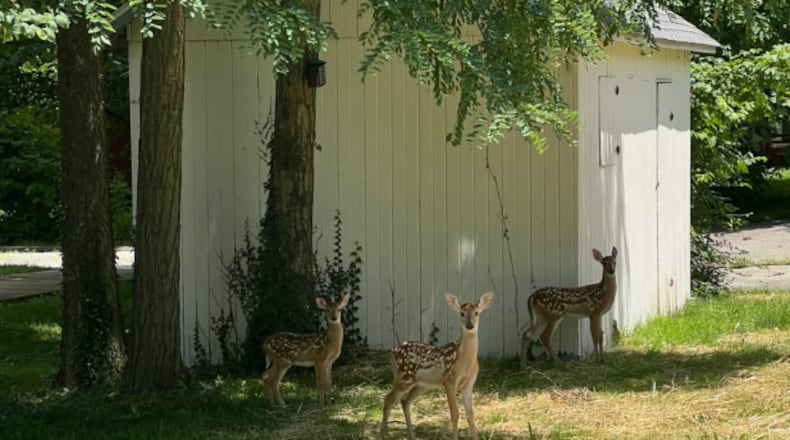Snavely said he can’t plant vegetable gardens anymore because the deer stole all of his tomatoes last year, and now he sprays all of his hostas with chemicals to protect them. He said he’s heard from plenty of residents with similar complaints who feel that the city needs to do more to curb the problem.
What the deer management program entails
Oxford already has a deer management program. From Sept. 30 to Feb. 4 this past season, 23 individuals participated in the bow-hunting program at approved locations within the city limits.
Oxford’s program requires that hunters donate their first deer to the Community Meal Center in Hamilton. This year, four deer total were harvested through the city’s program, while a fifth hunter struck a deer but couldn’t locate it. That marks the lowest harvest total since the program’s inception in 2009.
While the city had its s, that doesn’t include Miami University’s own program which began in 2022. Bow hunters can apply for licenses to hunt deer in several Miami’s natural areas over the same time period as the city. This past season, Miami reported 30 deer harvested from the natural areas, and another eight from the university’s Ecology Research Center (ERC). That total was up from five at the ERC and 15 in the natural areas during the 2022-23 season.
David Gorchov, a professor of biology and member of the university’s natural areas committee, said Miami’s deer management program shouldn’t have a negative impact on Oxford’s. The university gets more applications for licenses from qualified bow hunters than it can fulfill each year, and the deer populations are distinct, Gorchov said.
“The deer do move back and forth — the deer move onto farmland and in the township and so on, so deer are moving,” Gorchov said. “But the does in particular don’t move that much. The fact that we’re reducing densities in the natural areas is not really automatically going to make a big impact on the city.”
Is the program working?
Elea Cooper, a graduate student studying environmental science at Miami University, has studied deer density on Miami’s natural areas. In a 2023 study Cooper conducted, she found that deer density had declined since two 2014 and 2017 studies which used the same measurement methods. Even in using a second method relying on trail cameras, Cooper still found a decline in density.
In 2022, Cooper conducted a different study which found that seedlings and saplings were negatively impacted by high deer populations, which could have implications for the tree canopy in the future.
Other metrics also show that the deer problem may be improving. County-wide, deer-related accidents are down more than 50% compared to 2019 according to data from the Ohio State Highway Patrol. Statewide, deer-related accidents are down just 1% in the first half of the year compared to 2019 and are higher than the totals in 2020 and 2021.
Despite the decrease in accidents and studies showing less deer in Miami’s natural areas, some residents aren’t convinced. Joan Frybarger lives just south of Oxford’s corporate limits. She’s been gardening for more than 20 years, and she’s adapted her deer prevention strategies over the past decade to stop deer from eating her plants.
This year, Frybarger put bird netting over her plants like hostas to keep the deer off, plus she spread deer scram around the perimeter of her garden. She’s even taken to planning her garden out in advance with plants like bee balm and marigolds which deer are less likely to eat. Frybarger focuses on those plants and tries to surround the plants deer do like with others they don’t.
While Frybarger has strategies to protect her garden, she doesn’t see the problem improving.
“There has been at one point a half a dozen, a dozen of them out in the front part of the yard,” Frybarger said. “They’re to the point that they run out in traffic. They don’t seem to be afraid of anybody until you get right up on them almost.”
What more could be done?
At a city council meeting July 16, councilor David Prytherch said it’s time to reevaluate the effectiveness of the deer management program. Apart from concerns about gardening and car accidents, he said Lyme disease is on the threshold of Butler County. If the deer population increases, Prytherch suggested it could become an epicenter for the disease.
According to the Ohio Department of Health, Lyme disease is increasing statewide. Butler County averaged less than one case per year from 2013 until 2023, but it has had two so far in 2024.
Miami’s deer management program took in nearly 10 times as many deer as Oxford’s last season. Part of the difference, Gorchov said, could come from the license structure. The university divides its season into three hunting periods, allowing each of its 15 total areas to have three different hunters throughout the season. The city, meanwhile, does not rotate hunters.
“Even though we have a limited number of areas, we had three hunters at each area,” Gorchov said. “A lot of hunters, they just want one deer. So without greater effort, without having to take more sites, the city could, I think, increase the harvest.”
This season, the Ohio Department of Natural Resources also increased the bagging limit in Butler County from two to three deer. The archery season statewide runs Sept. 14, 2024 through Feb. 2, 2025.
This article first published in the Oxford Free Press, a content partner of the Journal-News. See it online at oxfreepress.com.
About the Author
